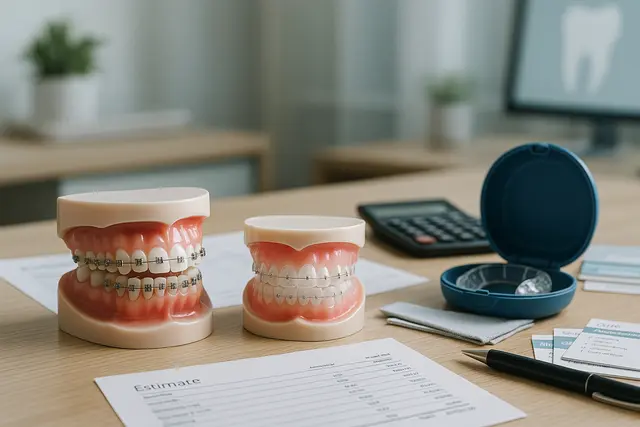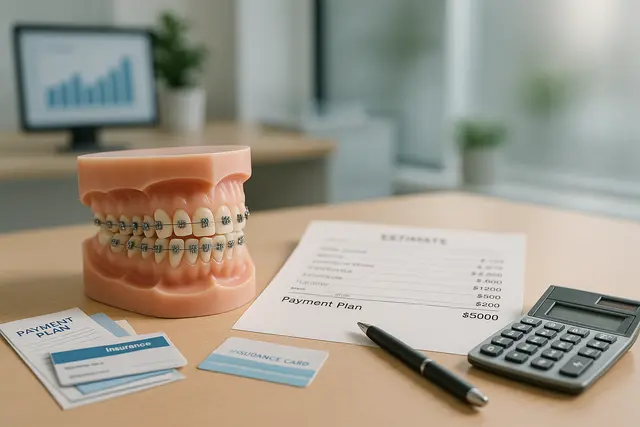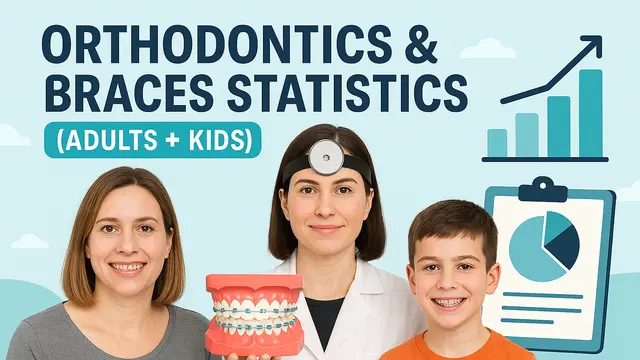Orthodontics
5 min read
Apr 03, 2025
Life After Braces: Retainer Use and Maintaining Your New Smile
The day the braces come off marks progress, but not the finish line. Teeth aren’t locked in place the moment treatment ends, they're still settling into their new positions. The next step, often overlooked, is just as important: retention. A retainer doesn't straighten your teeth; it keeps them straight. Without one, alignment changes over time are not just possible, they're likely.

You’ve made it. The day your braces come off feels like winning a gold medal in the Orthodontic Olympics. But before you run wild munching on crunchy apples and sticky candies, there’s one little device you’re going to hear a lot about: the retainer. Life after braces isn’t just about showing off your beautiful smile; it’s about making sure all that hard work sticks around for the long haul. So, what exactly should you expect once your braces are removed? Grab your toothpaste, floss, and sense of humor, let’s get into it.
Why Your Retainer is Your New Best Friend
After braces have been taken off, your teeth aren’t ready to settle down just yet. Teeth have a natural tendency to shift back toward their old positions, which is why wearing a retainer consistently is absolutely key. Think of your retainer as a personal bodyguard for your straight teeth, politely but firmly telling them to stay put.
Whether you rocked traditional braces or breezed through Invisalign treatment, your orthodontist will stress the same thing: wear your retainer. Skipping it "just for tonight" can lead to a lot of regret later. Your orthodontic treatment was an investment of time, effort, and money, and wearing your retainer is how you protect your investment.
From Braces to Freedom: What Changes and What Stays
Sure, life after braces feels amazing. No more wires poking your cheeks. No more avoiding crunchy snacks like popcorn and carrots. But don’t toss out your dental care routine with your old rubber bands. Keeping your smile straight means staying serious about oral hygiene.
You’ll still need to brush your teeth twice a day with a fluoride toothpaste and keep up with flossing to avoid plaque and food particles hiding in your newly aligned teeth and gums. Your general dentist might recommend a professional teeth whitening session if you notice white spots or discoloration after braces are removed. And regular dental checkups aren’t optional either, they’re part of keeping your smile for life.
Choosing the Right Type of Retainer
Not all retainers are created equal, and your orthodontist will recommend the best type of retainer for you. Some people get a fixed retainer, which is a thin wire bonded to the back of your teeth. It's like a secret agent, quietly doing its job without you needing to think about it too much.
Others may be given removable retainers, like the classic Hawley retainer or a clear plastic version that looks a bit like Invisalign trays. Removable retainers are great because they make cleaning your teeth a breeze, but only if you actually wear them. Whichever type you end up with, keeping your retainer clean and using a retainer case (instead of wrapping it in a napkin and accidentally throwing it away) will save you a lot of heartache.
Straighten Your Teeth, and Keep Them That Way
Getting orthodontic treatment isn’t a one-and-done deal. Braces may straighten your teeth, but retainers keep your teeth in place long enough for your bones and gums to fully support them. Active treatment might be over, but maintenance is forever.
Think of it like fitness: you don’t stop exercising after reaching your goal weight if you want to stay healthy. Same goes for your teeth. Follow your orthodontist’s instructions carefully and you’ll be flashing that beautiful smile without braces or invisalign for decades to come.
Living Without Braces: Freedom, with a Few Strings Attached
Life without braces comes with a lot of perks. You can crunch into apples, chew gum, and munch on popcorn without worrying about breaking a bracket. But the freedom comes with a slight string attached: your retainer.
In the beginning, you’ll probably have to wear your retainer all the time except for meals and brushing and flossing. Over time, you may only need to wear it at night. Trust us, a few extra hours of wearing a retainer is a small price to pay for keeping your teeth straight.
Your Dental Health Deserves VIP Treatment
Now that you have a new smile to show off, your dental health should stay top of mind. A clean mouth isn’t just about keeping teeth white; it’s about keeping gums healthy and preventing plaque from staging a comeback tour.
Brushing and flossing daily, sticking to fluoride toothpaste, and seeing your dentist regularly should be non-negotiables. Keeping your smile bright and healthy isn’t complicated, it just takes consistency.
Your Personalized Treatment Plan Doesn’t End Here
Even after braces are removed, your orthodontic journey continues with a custom treatment plan for retention. Some people might need a fixed retainer for years; others might graduate to wearing retainers only a few nights a week. It all depends on your specific needs, and your orthodontist will guide you every step of the way.
If you’re ever unsure about how often you should wear a retainer or notice it doesn’t fit like it used to, don’t wait, schedule a consultation right away. Teeth can move quicker than you think!
Keeping Your Teeth Straight: Daily Habits Matter
Tiny habits make a huge difference in keeping your teeth straight. Always wear your retainer as prescribed, keep your retainer clean (a soft toothbrush and cool water work wonders), and store it in a retainer case when it’s not in your mouth.
Also, if you grind your teeth at night, ask your dentist or orthodontist about extra protection like a nightguard. Grinding can slowly shift even the best-aligned teeth if left unchecked.
How to Protect Your Investment (and That New Smile)
Think about all the effort it took to get your braces or Invisalign treatment just right. The late nights with sore teeth. The crunchy foods you skipped. The floss-threaders you wrestled with.
Protecting your investment means treating your retainer like the VIP it is. Don’t expose it to heat (no boiling water, please). Don’t snap it into place aggressively. And don’t let pets anywhere near it, dogs think retainers are the world's most expensive chew toys.
Common Questions About Braces and Life After
Wondering how long you’ll have to wear a retainer? Curious if you can get teeth whitening after braces? Or maybe you're worried about what to do if your fixed retainer pops off? You’re not alone.
Questions about braces, retainers, and life after orthodontics are totally normal. Always feel free to ask your orthodontist anything, no question is too small when it comes to protecting your new smile and maintaining your results.
Final Thoughts: Smile for Life
The day you get your braces off is just the beginning of a new chapter. By committing to wear your retainer consistently, keeping up with your oral hygiene, and protecting your straight teeth, you're setting yourself up for a smile that truly lasts a lifetime.
Life after braces isn't just about looking great (although, let's be real, that's a huge bonus). It's about feeling confident, keeping your dental health strong, and enjoying the results of your orthodontic treatment every single day. So, wear your retainer, brush your teeth, floss like a pro, and smile like you mean it, because you earned it.
How Long Do I Need to Wear a Retainer After Braces?
Right after your braces come off, you’ll likely wear your retainer full-time for several months. Over time, your orthodontist may switch you to nighttime-only wear. Every case is different, so follow your orthodontist’s guidance to keep your teeth from shifting.
What Happens If I Don’t Wear My Retainer?
If you skip wearing your retainer, your teeth can gradually shift back toward their original positions. This movement can undo months or even years of orthodontic treatment, possibly requiring braces again to correct it.
What’s the Difference Between Fixed and Removable Retainers?
Fixed retainers are bonded wires placed behind your teeth and stay in 24/7. Removable retainers, like clear plastic trays or Hawley models, can be taken out for meals and brushing. Each has pros and cons, and your orthodontist will recommend the best one for your needs.
How Do I Take Care of My Retainer?
Clean your retainer daily with a soft toothbrush and cool water, avoid hot water, which can warp it. Always store it in its case when not in use, and keep it away from pets and heat. Proper care helps extend its life and keep it hygienic.
Read Next
Related Posts

Orthodontics
Retainer That Looks like Braces: Benefits for Long-Term Alignment
A retainer might not get as much attention as braces, but it plays a crucial role in maintaining your smile after orthodontic treatment. Whether you're new to retainers or curious about the type that looks like braces, understanding their purpose and benefits is key to keeping your teeth aligned for the long haul.
6 min read
Sep 15, 2025

Orthodontics
How Much Are Metal Braces? Cost Comparison With Other Options
Thinking about getting braces but overwhelmed by the cost? You’re not alone. Orthodontic treatment can be a major investment, and understanding the different price points, from metal braces to clear aligners, can help you make a smart, confident decision.
5 min read
Sep 15, 2025

Orthodontics
Orthodontics & Braces Statistics (Adults + Kids)
Orthodontics has transformed from a niche medical service for teenagers into a booming sector that spans all ages. Today, both adults and children seek orthodontic treatment to improve their smiles, fix bite issues, and boost self-confidence.
4 min read
Aug 21, 2025
Don’t have time to research every dentist around you?
See why 30k+ patients trusted us